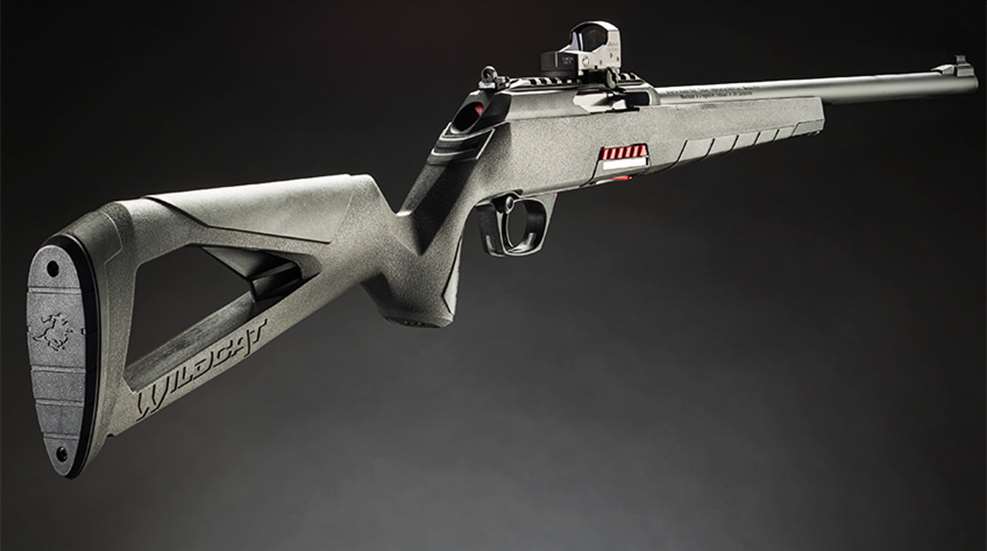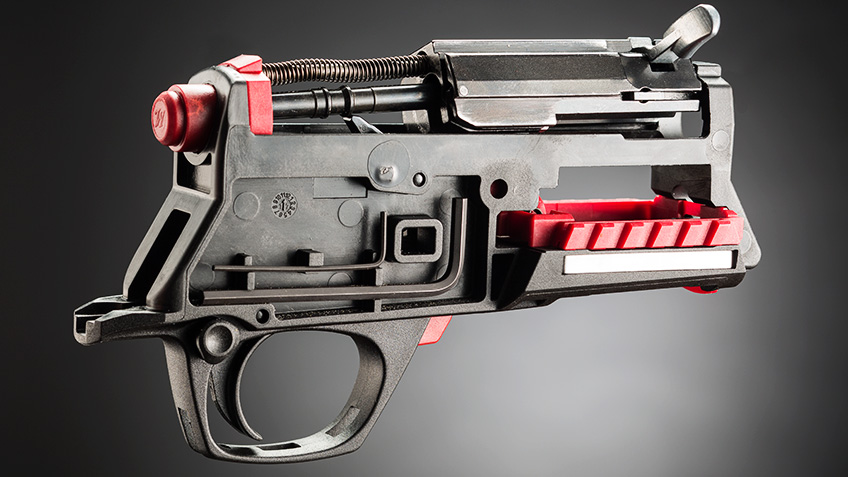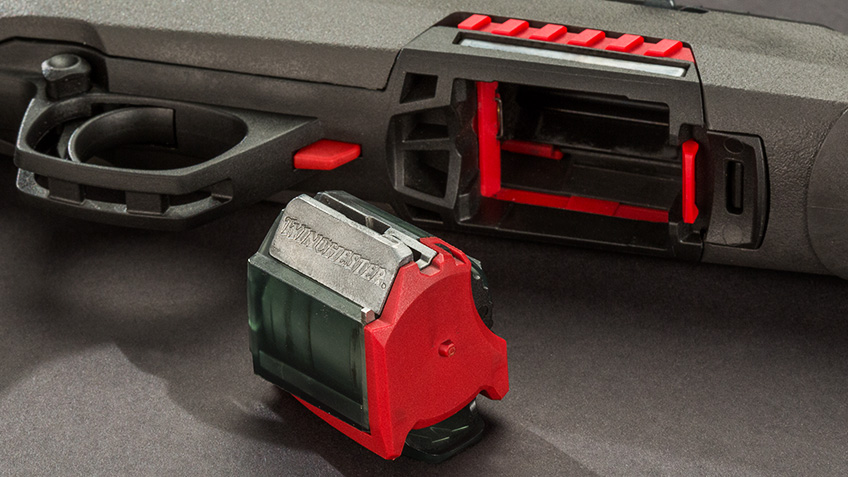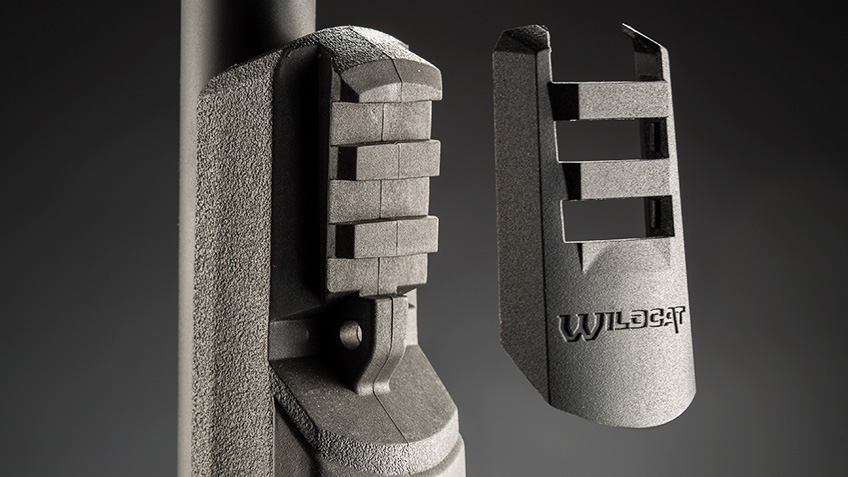
Winchester has produced some of the most notable firearms in American history, but the company’s contributions to the world of rimfire guns are often overlooked. It was Winchester, after all, that produced the venerable Model 52 bolt-action .22, lauded as the premier target rimfire of its time. Winchester’s first semi-auto rifle, the Model 63 .22, was introduced in 1933 and featured the first blowback action. In 1967, the Model 190 semi-auto rimfire was launched and more than a million were sold by the time production ended.

In January of this year, Winchester unveiled its new semi-auto .22 rifle—the feature-packed Wildcat.
A lot has changed in the .22 market since the mid-20th century. The blowback action Winchester debuted has been refined to near-perfection. Today’s rimfires benefit from modern machining and high-tech polymers, and there are good rifles available for moderate prices. If the Wildcat is going to compete with the likes of the vaunted Ruger 10/22, it has to bring a lot to the table. Fortunately, it does.

The Wildcat uses a blowback action, but unlike other rimfires it utilizes a striker-fired design with a hemispheric firing pin that is more efficient than traditional designs. The design allows for a very light, crisp trigger pull and decreases lock time. The action is mated with an 18-inch chrome-moly steel barrel with a recessed target crown, and is fed from a detachable rotary box magazine that holds 10 rounds (the Wildcat also accepts Ruger 10/22 aftermarket mags). A lightweight gray polymer stock with a skeletonized rear section comes standard, and the Wildcat is equipped with iron sights (fully adjustable peep rear and post front) and a top rail for mounting optics. The stock is also equipped with molded polymer sling eyelets and a Picatinny rail section with a removable cover. Lightweight composites help to keep the Wildcat’s weight to just 4 pounds. The rifle has an overall length of just over 3 feet, and length of pull is 13½ inches. Despite its small size, the Wildcat packs a ton of innovative, user-friendly features into a lightweight package.
What makes the Wildcat a standout in the .22 rimfire market is the number of intelligent features that have been engineered into it. First, the lower receiver assembly quite literally falls into your hand with the touch of a button. With the rifle unloaded and the magazine removed, simply press the red button at the rear of the upper assembly and the inner workings of the receiver drop free. This allows for thorough cleaning (from breech to barrel) and unmatched ease of maintenance. And don’t fret if you’ve forgotten your tools—there are Allen wrenches stored on the lower assembly that allow you to adjust the sights or remove the barreled action from the stock. To replace the lower assembly, simply rotate the bolt handle up and reinsert until it locks in place.

The Wildcat’s molded polymer stock features modern styling with all the associated lines and angles, but it’s well-designed. There’s a finger groove on the flat-bottom forearm and the comb of the stock rises front to back. The pistol grip is rather narrow and steeply angled, and recesses molded into the junction between the grip and the stock form a natural resting point for the ball of the shooter’s hand. The rear of the receiver is also angled, perhaps a nod to the original Model 63 design. Controls are well-thought-out and user-friendly: there’s a crossbolt safety behind the trigger guard, and in front of the guard there’s a red slide lock button that allows you to manually lock the slide open. Nestled against the right side of the receiver is a red recessed slide release button. The rotary magazine fits snugly into the rifle and can be released in two ways: if you’re a traditionalist, you can drop the mag by pulling back on a red release tab at the front of the magazine well, but I much prefer using the red side-mounted rails that are located just above the magazine. Simply pull back on the rail and the mag drops into the hand.

Winchester’s rear peep sight is easy to adjust (especially since you always have an Allen wrench available), but I’d imagine most shooters will opt for an optic or red dot to wring maximum accuracy from this rifle. Atop my test rifle was a lightweight and durable red-dot optic that’s perfectly suited for the Wildcat. I tested five different .22 loads at 50 yards, and at that range the Winchester was capable of producing groups as small as .73-inch. Likewise, I tested ammunition with a wide range of velocities. At the low end of the velocity range was Lapua’s Midas+ target ammo, which didn’t have any issues with cycling whatsoever. I also tested CCI’s fast Mini-Mag SHP load, which is ideal for small game with a muzzle velocity of 1200 fps. Throughout the testing there were no issues with feeding, extraction or ejection. The trigger had minimal take-up and broke at 4½ pounds, and after shooting the rifle for a short time I grew accustomed to the controls. The crossbolt safety is well-positioned, and it’s possible to operate the safety quietly so as not to spook game when hunting.
Thanks to my caffeine addiction, there was a soda can in the console of my pickup truck which provided a perfect plinking target. Using Winchester’s Wildcat ammo, I punched a few dozen holes in the aluminum can. The Wildcat is a lot of fun to shoot, and it provides cheap thrills—with an MSRP of $249.99 you can expect to see these guns available around $200, which is a small price to pay for such an appealing little rimfire rifle.

Technical Specifications
• Type: blowback-operated, semi-automatic rimfire rifle
• Caliber: .22 Long Rifle
• Barrel: 18″; chrome-moly steel; button-rifled; 6 grooves; 1:16″ RH twist
• Magazine: 10-rnd. rotary; compatible with Ruger 10/22 magazines
• Trigger: single stage; polymer construction; pull weight 4.5 lbs.
• Sights: fully-adjustable ghost ring rear, ramped post front; Picatinny rail integral to receiver for mounting optics
• Safety: two-position crossbolt
• Stock: molded black polymer skeletonized stock w/integral Picatinny rail in fore-end
• Metal Finish: matte blued barrel, matte black receiver and bolt
• Overall Length: 36.25″
• Weight: 4 lbs.
• MSRP: $249.99; winchesterguns.com




































